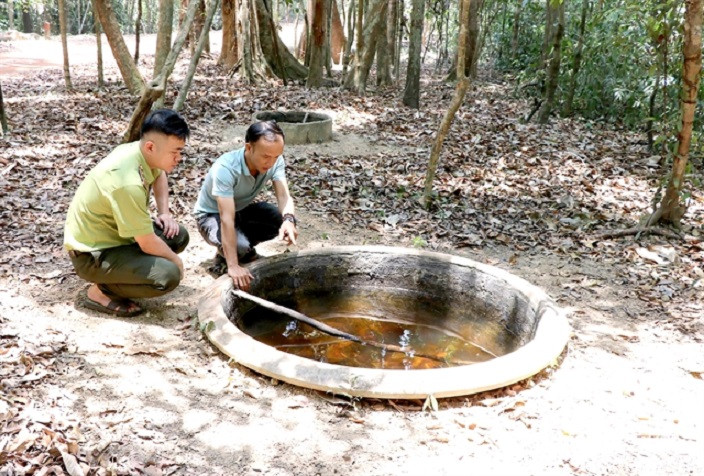
The rangers transport water by vehicles and traverse dozens of kilometers to replenish the containers twice a month.
Hà Chí Lực of the reserve’s Forest Protection Division, said two giant water pans have also been built to provide water for elephants.
They are each hundreds of square meters in size and hold 300cu.m of water sourced from borewells, he said.
“During the current peak of the dry season most water sources in forests have dried up. Therefore, the water supply sites for animals are really useful and are considered a precious source for wild animals to come to drink. At the water pans, rangers have recorded elephants often coming to drink water,” he said.
Beside the containers, the rangers hang salt and minerals such as magnesium, calcium and phosphorous on trees for animals.
The southeastern provinces, including Đồng Nai, have recorded 35-37 degrees Celsius regularly since the middle of February, according to the South Region Centre for Hydro-Meteorology Forecasting.
Võ Quang Trung, deputy head of the reserve’s Nature Preservation and Co-Operation Division, said the dry season in the southeast normally lasts six months and by now most water bodies in the forests have dried up.
“We see many animals coming to drink water and eat the minerals. They include large animals such as deer and gaur and small animal such as weasels and mouse-deer, reptiles and amphibians.”
The reserve has carried out the programme for providing water and minerals for animals in the dry season for the last six years.
The programme aims to enhance living conditions for wild animals, especially in the dry season, to stabilise their habitat.
It also improves the effectiveness of conservation, especially of rare and endangered animals.
It also aims to create natural places for watching wild animals in future, raise the public’s awareness of protecting natural resources and environment, serve scientific research, and serve ecological tourism.
Every year the reserve evaluates the effectiveness of providing drinking water and mineral nutrients for wild animals. Through actual inspection and camera traps, it finds that a large number of animals to come to drink water and consume the minerals.
The reserve has an area of more than 100,000ha, with more than 1,800 animal and 1,500 plant species, including large and rare animals such as elephants and gaur.
In 2015, 43 of its plants and 25 animals were listed in the IUCN Red List, the world’s most comprehensive source of information on the global extinction risk status of flora and fauna.
It had 36 plant species and 27 animal species listed in Việt Nam’s Red Book of Endangered Species in 2007.
According to experts, it plays an important role in conserving biodiversity, protecting the environment, and regulating water resources. It is a green lung of the southeastern region.
It has been recognised as a UNESCO biosphere reserve. – VNS